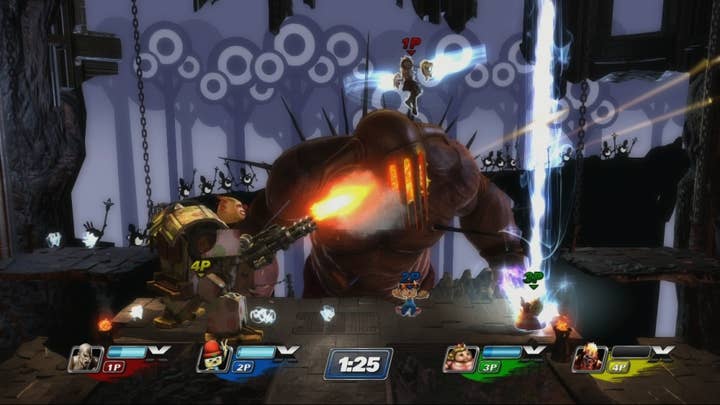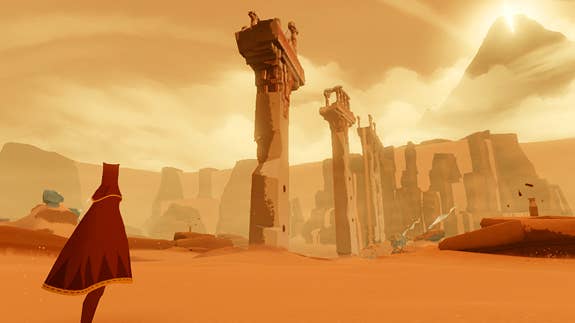God of Ware: Inside Sony Santa Monica
From promoting diversity to nurturing fresh talent, Sony's West Coast development hub is a role model for the industry - but there are warning signs too, writes Johnny Minkley
Oddly, the most persuasive explanation for Sony Santa Monica's success comes from a man who has decided not to renew his working relationship with the studio.
Relaxing with a coffee in the searing LA sunshine last week, Thatgamecompany's Jenova Chen says: "I still recall clearly that two months before we were due to ship Flower, we told Sony: 'We'll ship it December', and they came to me to say: 'We think if you get two more months this game will be even better, so here's the money, just polish it a little bit more'."
Sony came to me to say: 'We think if you get two more months this game will be even better, so here's the money, just polish it a little bit more'
Jenova Chen
How many independent developers have had that conversation with a major publisher? Not least for a game, Chen notes, that was pitched to Sony as: "We want to make a game about giving love".
The three-game deal struck with his studio produced the eclectically esoteric, critically-acclaimed trio of fl0w, Flower and Journey. All of which, Chen adds with a chuckle, "failed to deliver in the original time we proposed.
"I would imagine that's probably impossible for Activision or Microsoft to do. They'd be just like, you have to ship by this day." An interesting conundrum for his studio, then, which is currently looking for a new publishing partner having fulfilled its contractual duties with Sony.
Sony Santa Monica's responsibilities cover the full spectrum of PlayStation content, from the internally-produced, blockbuster God of War series, all the way down to the small-team indie oddities it gently coaxes into life.
It's unusual to see such a divergent range of approaches to content coming from a single studio model: of the current crop, God of War: Ascension is the resource-heavy franchise extension; PlayStation All-Stars the marketing department-approved genre title; Journey the commercially-risky arthouse labour of love.
The first two are what you'd expect from a first-party (though it's worth noting All-Stars is from SuperBot, a new 100-strong indie heavily supported by Sony). But it's titles such as the latter, games "incubated" - in the official parlance - by the company that suggest a different approach to content acquisition and talent management from the norm.
"There's so many budding creatives out there and we're always looking at ways to push the medium forward," says Shannon Studstill, Sony Santa Monica studio director, speaking in a quiet corner at the chaotic press unveiling of the latest God of War.

"We go everywhere from colleges to kids right out of high school in some cases, bring them in and really see what they have to offer," she continues. "The incubation programme is one we hope to continue to expand upon - and that is an opportunity for us to really work closely with these young creatives and help them to build a foundation for product development for their future and, ideally, for ours."
Scouting out hot new local talent is hardly a new strategy, but one key difference is the degree of freedom afforded to Santa Monica by Sony to back pet projects with its considerable technical and financial muscle.
It's a far more collaborative approach overall, with a bespoke level of intervention. It's also costlier, more demanding of time and labour, and comes with absolutely no guarantee of commercial success at the other end. But without it, a title like Journey simply wouldn't exist.
"Every person's different on a team and every team is different: there's a different culture and a different make up," says Studstill. "What we try to do is get in, get a sense of who the leadership is, who's really the person that's instrumental in driving the vision - which is typically the creative director - and really band around that person and give them the support they need from kind of a mentoring style programme.
It will be fascinating to see what changes Phil Harrison is able to effect within Xbox, with Sony's current approach owing much to the punt-taking culture he encouraged as Worldwide Studios boss
"In some cases we're deep into their development really helping them, bringing a lot of our senior leadership into that," she explains. "In some cases it's not all that necessary; they're already driving themselves and they know what good looks like, they know what fun feels like and we're really on the outskirts making sure the way they're looking to the future of their game is foundationally sound".
"Sony has been very supportive, particularly creatively with us," Chen agrees, separately. "I do not know the exact detail of how they work with others, but our relationship is really great. I've never felt like I was told to make games a certain way."
Geography helps. The walk from Santa Monica studios to meet Chen at his local Starbucks a few blocks away takes me past Uncharted developer Naughty Dog. But even if Sony's rivals had bases here, it's hard to imagine they'd have been anywhere near as chummy with the indie community.
Chen is blunt on this point. "I think there is a DNA that we share [with Santa Monica], which is we wanted to make a game that's not only entertaining for the younger generation, but also a great experience for adults.
"We're always interested in the artistic side, to make games that people who are 30, 35 can still appreciate - something I don't really see by talking to Nintendo people or Microsoft."

Which is one reason why it'll be fascinating to see what changes Phil Harrison is able to effect within Xbox, with Sony's current approach owing much to the punt-taking culture he encouraged as Worldwide Studios boss.
Another vitally important area that marks Santa Monica out is the diversity of its workforce. The profound lack of females employed in creative roles in games development, let alone management positions, remains a great stain on the character of the wider industry.
Sony's Californian office bucks this trend dramatically, not only in its senior team. "I'll tell you, Sony Santa Monica right now is comprised of probably about 22-24 percent female," reveals Studstill. Way above the industry average, in other words.
"I'm very proud of that and hope to expand upon it," she says. "We really need to be giving the general public an understanding of the fact that you have a shot at being in games as a female, and I think we can do that at the high school and college level better.
"It's up to us to telegraph that, advertise it; it's up to the female to go, 'oh, this is cool, I can do this', and look at all aspects of what that means from engineering to design to production. And then it's up to the leadership within the studio to give that person a shot."
We need to be giving the general public an understanding of the fact that you have a shot at being in games as a female, and I think we can do that at the high school and college level
Shannon Studstill, Sony Santa Monica
All of which is hugely admirable. Which begs the question, if everything is so rosy and smooth, why isn't Thatgamecompany making its next game with Sony? Why would a creative praise their shared "DNA" then go elsewhere?
There's palpable disappointment, even sadness, within Sony that the partnership with Chen and his team is at an end; but a grudging acceptance that there are other platforms and audiences he probably wants to target with future titles.
If Santa Monica has a problem, then, it's one it has little control over: an industry in a massive state of flux where no-one can be certain which way it will turn. In such circumstances, one can hardly blame an independent studio with the wind in its sails for keeping its options open.
"I feel like [the industry] is very schizophrenic these days," acknowledges Studstill. It's really hard to break through and see what that path is. But that's why we at Santa Monica really believe in that visionary, in the person that's out there seeing something that no-one else is seeing.

"We've just got to have the trust in that one person to work with his or her team to really push that medium forward. We've got to believe in that. We as an industry need to believe in that and move it forward."
There's no doubt the Santa Monica method has already done just that. But the question for Sony is, in discovering and nurturing brilliant new talent, can it keep hold of it?

